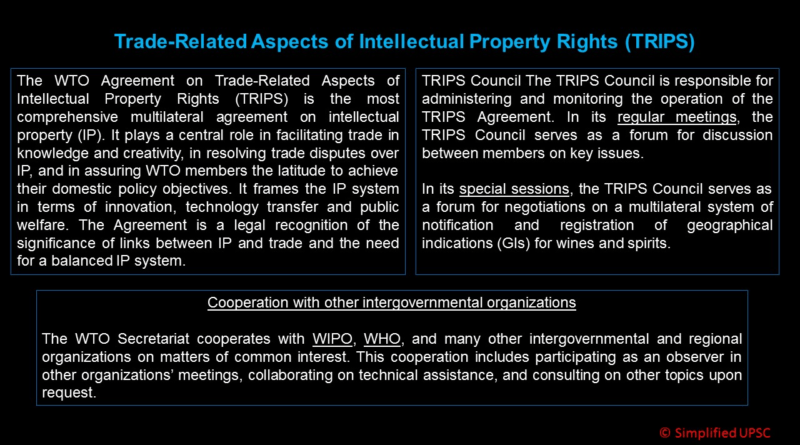The Agreement on Trade-Related Aspects of Intellectual Property Rights (TRIPS)
About TRIPS:
- The Agreement on Trade-Related Aspects of Intellectual Property Rights (TRIPS) is an international legal agreement between all the member nations of the World Trade Organization (WTO).
- It establishes minimum standards for the regulation by national governments of different forms of intellectual property (IP) as applied to nationals of other WTO member nations.
- TRIPS was negotiated at the end of the Uruguay Round of the General Agreement on Tariffs and Trade (GATT) in 1994 and is administered by the WTO.
- In 2001, developing countries, concerned that developed countries were insisting on an overly narrow reading of TRIPS, initiated a round of talks that resulted in the Doha Declaration. The Doha declaration is a WTO statement that clarifies the scope of TRIPS, stating for example that TRIPS can and should be interpreted in light of the goal “to promote access to medicines for all.”
- TRIPS also specifies enforcement procedures, remedies, and dispute resolution procedures. Protection and enforcement of all intellectual property rights shall meet the objectives to contribute to the promotion of technological innovation and to the transfer and dissemination of technology, to the mutual advantage of producers and users of technological knowledge and in a manner conducive to social and economic welfare, and to a balance of rights and obligations.
- India has ratified the Trade Facilitation Agreement (TFA) of the World Trade Agreement (WTO) and the instrument of Acceptance for Trade Facilitation Agreement was handed over to WTO Director-General by India on April 22, 2016
- India is the 76th WTO member to accept the TFA.
- TFA sets out measures for effective cooperation between customs and other appropriate authorities on trade facilitation and customs compliance issues.
- Specifically, TRIPS requires WTO members to provide copyright rights, covering authors and other copyright holders, as well as holders of related rights, namely performers, sound recording producers and broadcasting organisations; geographical indications; industrial designs; integrated circuit layout-designs; patents; new plant varieties; trademarks; trade names and undisclosed or confidential information.
Post-TRIPS expansion (TRIPS-Plus)
In addition to the baseline intellectual property standards created by the TRIPS agreement, many nations have engaged in bilateral agreements to adopt a higher standard of protection. These collection of standards, known as TRIPS+ or TRIPS-Plus, can take many forms. General objectives of these agreements include:
- The creation of anti-circumvention laws to protect Digital Rights Management systems. This was achieved through the 1996 World Intellectual Property Organization Copyright Treaty (WIPO Treaty) and the WIPO Performances and Phonograms Treaty.
- More stringent restrictions on compulsory licenses for patents.
- More aggressive patent enforcement. This effort has been observed more broadly in proposals for WIPO and European Union rules on intellectual property enforcement. The 2001 EU Copyright Directive was to implement the 1996 WIPO Copyright Treaty.
- The campaign for the creation of a WIPO Broadcasting Treaty that would give broadcasters (and possibly webcasters) exclusive rights over the copies of works they have distributed.
Although they are named as ‘TRIPS-Plus,’ they are not formally related to TRIPs. Rather, the term is used to indicate that these requirements go beyond the minimum standards imposed by TRIPs. Many developing countries who are members of FTAs are under pressure to enact these tougher conditions in their patent laws.
The developing countries have concerns over the higher level of protection demanded by the developed world. They fear that once such levels of protection are given multilaterally, it will reduce competition and may led to price rise of medicines, affecting health security in poor countries.
The TRIPS Agreement covers five broad areas:
- how general provisions and basic principles of the multilateral trading system apply to international intellectual property
- what the minimum standards of protection are for intellectual property rights that members should provide
- which procedures members should provide for the enforcement of those rights in their own territories
- how to settle disputes on intellectual property between members of the WTO
- Special transitional arrangements for the implementation of TRIPS provisions.
TRIPS Significance
The TRIPS Agreement makes protection of intellectual property rights an integral part of the multilateral trading system, as embodied in the WTO. The agreement is often termed one of the three “pillars” of the WTO, the other two being trade in goods (the traditional domain of the GATT) and trade in services.
Before TRIPS, the extent of protection and enforcement of IP rights varied widely across nations and as intellectual property became more important in trade, these differences became a source of tension in international economic relations. Therefore, it was considered prudent to have new trade rules for IP rights in order to have more order and predictability, and also to settle disputes in an orderly manner.
Criticism
Since TRIPS came into force, it has been subject to criticism from developing countries, academics, and non-governmental organizations. Though some of this criticism is against the WTO generally, many advocates of trade liberalisation also regard TRIPS as poor policy. TRIPS’s wealth concentration effects (moving money from people in developing countries to copyright and patent owners in developed countries) and its imposition of artificial scarcity on the citizens of countries that would otherwise have had weaker intellectual property laws, are common bases for such criticisms. Other criticism has focused on the failure of TRIPS to accelerate investment and technology flows to low-income countries, a benefit advanced by WTO members in the lead-up to the agreement’s formation. Statements by the World Bank indicate that TRIPS has not led to a demonstrable acceleration of investment to low-income countries, though it may have done so for middle-income countries. Lengthy patent periods under TRIPs have been scrutinized for unduly slowing the entry of generic substitutes and competition to the market. In particular, the illegality of pre-clinical trials or submission of samples for approval until a patent expires have been blamed for driving the growth of a few multinationals, rather than developing country producers.
TRIPS-plus conditions mandating standards beyond TRIPS have also been the subject of scrutiny. These FTA agreements contain conditions that limit the ability of governments to introduce competition for generic producers. In particular, the United States has been criticised for advancing protection well beyond the standards mandated by TRIPS. The United States Free Trade Agreements with Australia, Morocco and Bahrain have extended patentability by requiring patents be available for new uses of known products.The TRIPS agreement allows the grant of compulsory licenses at a nation’s discretion. TRIPS-plus conditions in the United States FTA’s with Australia, Jordan, Singapore and Vietnam have restricted the application of compulsory licenses to emergency situations, antitrust remedies, and cases of public non-commercial use.

Copyright
Copyright usually refers to the rights of authors in their literary and artistic works. In a wider sense, copyright also includes ‘related rights’: the rights of performers, producers of phonograms and broadcasting organizations.
Trademarks
A trademark is a sign or a combination of signs used to distinguish the goods or services of one enterprise from another.
Geographical indications
A name or indication associated with a place is sometimes used to identify a product. This “geographical indication” does not only say where the product comes from. More importantly, it identifies the product’s special characteristics, which are the result of the product’s origins.
Well-known examples include “Champagne”, “Scotch Whiskey”, “Tequila”, “Darjeeling” and “Roquefort” cheese.
Industrial designs
Industrial design is generally understood to refer to the ornamental or aesthetic aspect of an article rather than its technical features.
Under the TRIPS Agreement, original or new industrial designs must be protected for at least 10 years.
Patents
A patent is an exclusive right granted for an invention, which is a product or a process that provides, in general, a new way of doing something, or offers a new technical solution to a problem. To get a patent, technical information about the invention must be disclosed to the public in a patent application. They must be protected for at least 20 years.
Layout designs of integrated circuits
An integrated circuit is an electronic device that incorporates individual electronic components within a single ‘integrated’ platform configured to perform an electronic function.
Intellectual Property Rights
Intellectual property rights are the rights given to persons over the creations of their minds. Intellectual property rights (IPRs) are legal rights that protect these creations. In contrast to rights over tangible property, IP rights give their owners rights to exclude others from making use of their creations only for a limited period. IP rights entitle the owners to receive a royalty or any sort of financial compensation or payment when another person uses their creations
Source: TRIPS



